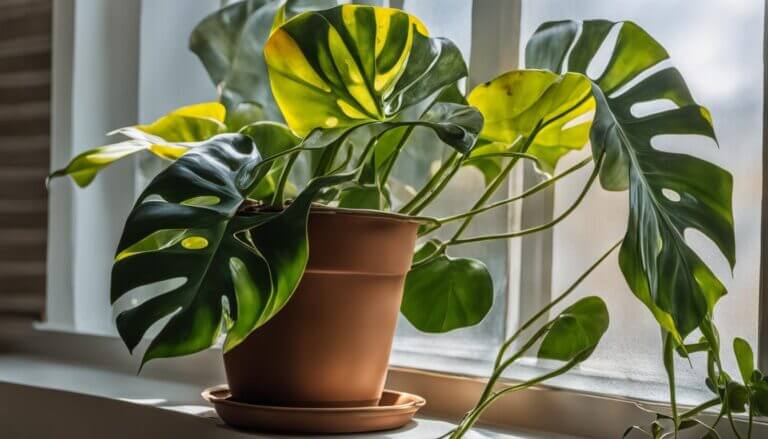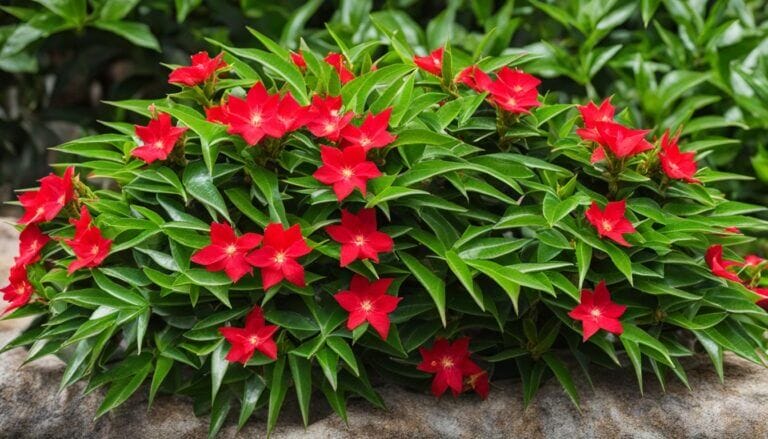Why Philodendron Leaf Curl? Possible Causes and Solutions
Are your philodendron leaves curling, causing you to worry about the health of your beloved plants? Fear not, for we have the answers you seek.
In this informative article, we will delve into the various causes and solutions behind this perplexing phenomenon. From environmental factors to pests and diseases, watering issues to nutritional deficiencies, we will explore every angle to ensure your philodendrons thrive.
So, join us on this journey and discover the secrets to keeping your philodendron leaves straight and stunning.
Key Takeaways
- Environmental factors such as insufficient or excessive light and temperature fluctuations can cause philodendron leaves to curl.
- Pests and diseases like mealybugs, spider mites, aphids, bacterial leaf spot, and fungal infections can also lead to leaf curling.
- Watering issues, including overwatering and underwatering, can contribute to leaf curling and other problems.
- Nutritional deficiencies, particularly lack of nitrogen, phosphorus, and potassium, can cause leaf curling, yellowing, and stunted growth. Regular monitoring and balanced fertilization can help prevent deficiencies.
Environmental Factors Could Cause Philodendron Leaf Curl
While there may be several causes for philodendron leaves to curl, it is important to consider the impact of environmental factors.
One such factor is light exposure. Philodendrons thrive in bright, indirect light. Insufficient light can cause the leaves to curl as the plant tries to maximize its exposure to light. On the other hand, excessive light can also lead to leaf curling, as the plant may be trying to protect itself from sunburn.
Another environmental factor to consider is temperature fluctuations. Philodendrons prefer a stable temperature between 65 to 85 degrees Fahrenheit. Drastic changes in temperature, such as cold drafts or being placed near heating vents, can cause the leaves to curl.
It is important to provide a consistent and stable environment for your philodendron to prevent leaf curling.
Prevent Philodendron Leaves From Curling Check For Pests and Diseases
Several pests and diseases can contribute to the curling of philodendron leaves. It is important to be aware of these potential problems in order to effectively treat and prevent them.
Here are some common pests that can affect philodendrons:
- Mealybugs: These small, white insects feed on the sap of the plant, causing leaf curling and yellowing. They can be identified by their cotton-like appearance.
- Spider mites: These tiny pests also feed on the sap of the plant, leading to leaf discoloration and curling. They are often found in clusters on the undersides of leaves.
- Aphids: These small, soft-bodied insects can cause distorted growth and curling of leaves as they suck out the sap.
In addition to pests, there are also diseases that can affect philodendron plants, such as bacterial leaf spot and fungal infections. These can cause leaf curling, discoloration, and wilting.
Understanding the common pests and diseases that can affect philodendrons is essential for maintaining the health and appearance of your plants.
Now, let’s move on to the next section, which will address watering issues and their impact on philodendron leaf curling.
Causes of Philodendron Leaf Curling – Watering Issues
Watering issues can significantly contribute to the curling of philodendron leaves. Overwatering consequences can lead to root rot, which inhibits the plant’s ability to absorb nutrients and water properly. When the soil is constantly saturated, it creates an environment that is perfect for fungal growth and bacterial infections. This can result in the wilting and yellowing of leaves, as well as the curling.
On the other hand, under watering symptoms include dry, crispy leaves that may also curl in an attempt to retain moisture. It is crucial to find a balance between watering too much and too little to maintain the health of your philodendron.
Now, let’s move on to another potential cause of leaf curling: nutritional deficiencies.
Common Causes Curling Philodendron Leaves – Nutritional Deficiencies
A significant factor contributing to the curling of philodendron leaves is the lack of essential nutrients, such as nitrogen, phosphorus, and potassium. These nutrients are necessary for the proper growth and development of plants, including philodendrons. When a philodendron lacks these nutrients, it can lead to various signs of nutritional deficiencies.
Common signs of nutritional deficiencies in philodendrons include:
- Yellowing or browning of leaves
- Stunted growth
- Leaf curling or distortion
To prevent nutritional deficiencies in philodendrons, consider the following tips:
- Use a well-balanced fertilizer specifically formulated for houseplants.
- Follow the recommended dosage and application instructions.
- Regularly monitor the plant for signs of nutrient deficiencies and adjust the fertilizer accordingly.
Improper Care and Maintenance
Frequently overlooked, but a crucial factor contributing to the curling of philodendron leaves is improper care and maintenance.
One common mistake is overwatering. Philodendrons require well-draining soil, and excessive watering can lead to root rot and other fungal diseases. It’s important to allow the top inch of soil to dry out before watering again.
Additionally, philodendrons thrive in bright, indirect sunlight. Too much direct sunlight can scorch the leaves, causing them to curl and turn brown. On the other hand, insufficient sunlight can result in weak growth and pale leaves. Finding the right balance is key. Regularly rotating your plant or providing a sheer curtain can help regulate the amount of sunlight it receives.
Frequently Asked Questions
Can a Philodendron with Drooping Leaves Also Have Curling Leaves?
If you notice your philodendron with drooping leaves, it is possible that curling leaves may also be present. To combat these issues, you can follow some steps on how to fix drooping philodendron leaves. Analyze your watering routine, ensure proper drainage, adjust lighting conditions, and maintain the appropriate humidity level to revive your plant’s health and restore its vitality.
Can Brown Spots on Philodendron Leaves Cause Curling?
The causes of brown spots on philodendron leaves can lead to curling. These spots can result from various factors such as fungal infections, nutrient deficiencies, or excessive sunlight exposure. Identifying the specific cause is crucial for successful treatment and prevention of further leaf damage. Consulting a plant expert or conducting thorough research can help diagnose and address the issue effectively.
Can Overwatering Cause Philodendron Leaves to Curl?
Overwatering can indeed cause philodendron leaves to curl. This is because excessive moisture can lead to root rot and hinder the plant’s ability to absorb nutrients.
However, it’s important to note that overwatering can have different effects on other houseplants and may manifest in various ways depending on the species. Signs of overwatering in different plant species include yellowing leaves, wilting, and the presence of fungus or mold.
Proper watering practices and monitoring the plant’s moisture needs are crucial for maintaining healthy foliage.
Are There Any Specific Pests That Commonly Attack Philodendron Plants?
Philodendron plants can be susceptible to various pests that can negatively impact their health and appearance. Common pests that attack philodendron include spider mites, mealybugs, aphids, and scale insects.
These pests feed on the plant’s sap, causing leaves to curl, yellow, or develop spots.
It is important to regularly inspect your philodendron for signs of pest infestation and take appropriate measures to control and eliminate them. Proper hygiene, regular monitoring, and targeted treatments can help protect your philodendron from pest damage.
How Often Should I Fertilize My Philodendron to Prevent Nutritional Deficiencies?
To prevent nutritional deficiencies in your philodendron, it is important to fertilize it regularly. Fertilizer frequency depends on several factors including the type of fertilizer used, the size of the plant, and the environment it is grown in.
Generally, it is recommended to fertilize philodendrons every 4-6 weeks during the growing season. This helps ensure that the plant receives the necessary nutrients to support healthy growth and prevent deficiencies that could lead to issues such as curled leaves.
Can Using Tap Water Instead of Distilled Water Affect the Health of My Philodendron?
Using tap water instead of distilled water can have an impact on the health of your philodendron. The quality of water plays a significant role in the growth of plants.
Tap water may contain minerals and chemicals that can build up in the soil over time, leading to nutrient imbalances and affecting the overall health of your philodendron.
It is recommended to use distilled or filtered water to ensure the best possible water quality for your plants.
Is It Necessary to Trim or Prune My Philodendron Regularly to Prevent Leaf Curling?
Pruning frequency and methods play a significant role in maintaining the health and appearance of philodendron plants. Regular pruning helps to prevent leaf curling by removing diseased or damaged leaves, allowing more airflow and light penetration to the plant. It also promotes branching, resulting in a fuller and more compact growth habit.
However, if pruning is not preferred, there are alternative methods to prevent leaf curling. These include maintaining proper watering, humidity levels, and providing adequate light conditions.
Why are my philodendron leaves curling?
Philodendron leaves are curling usually due to changes in humidity, over-fertilization, or exposure to direct sunlight. It’s important to identify the cause and find appropriate solutions.
Can humidity cause leaf curling in philodendrons?
Yes, philodendrons are tropical plants and prefer high humidity. If the indoor humidity is too low, the leaves may start to curl inward.
How does fertilizer affect my philodendron’s leaves?
Over-fertilization can cause the leaves of your philodendron to curl due to the buildup of salt and other minerals. It’s best to fertilize your philodendron sparingly and ensure proper drainage.
Can direct sunlight make the leaves on my philodendron curl?
Yes, direct sunlight can cause the leaves on your philodendron to curl and turn yellow. Philodendrons prefer indirect light.
What are the possible causes of brown spots on my philodendron’s leaves?
Brown spots on your philodendron’s leaves could be a sign of root rot or a fungal infection. Overwatering and poor drainage are common causes.
Why are my philodendron leaves turning yellow?
Philodendron leaves turning yellow can be a sign of overwatering or lack of nutrients. It’s important to water your philodendron properly and provide it with a balanced fertilizer.
How can I prevent my plant leaves from curling?
To prevent curling, ensure your plant is getting the right amount of water, not exposed to direct sunlight, and is in a humid environment. Regularly check for signs of pests or disease.
What should I do if I see my philodendron’s leaves are curling?
If your philodendron’s leaves are curling, try adjusting its care routine. This might involve changing how often you water it, moving it out of direct sunlight, or adjusting the humidity levels.







